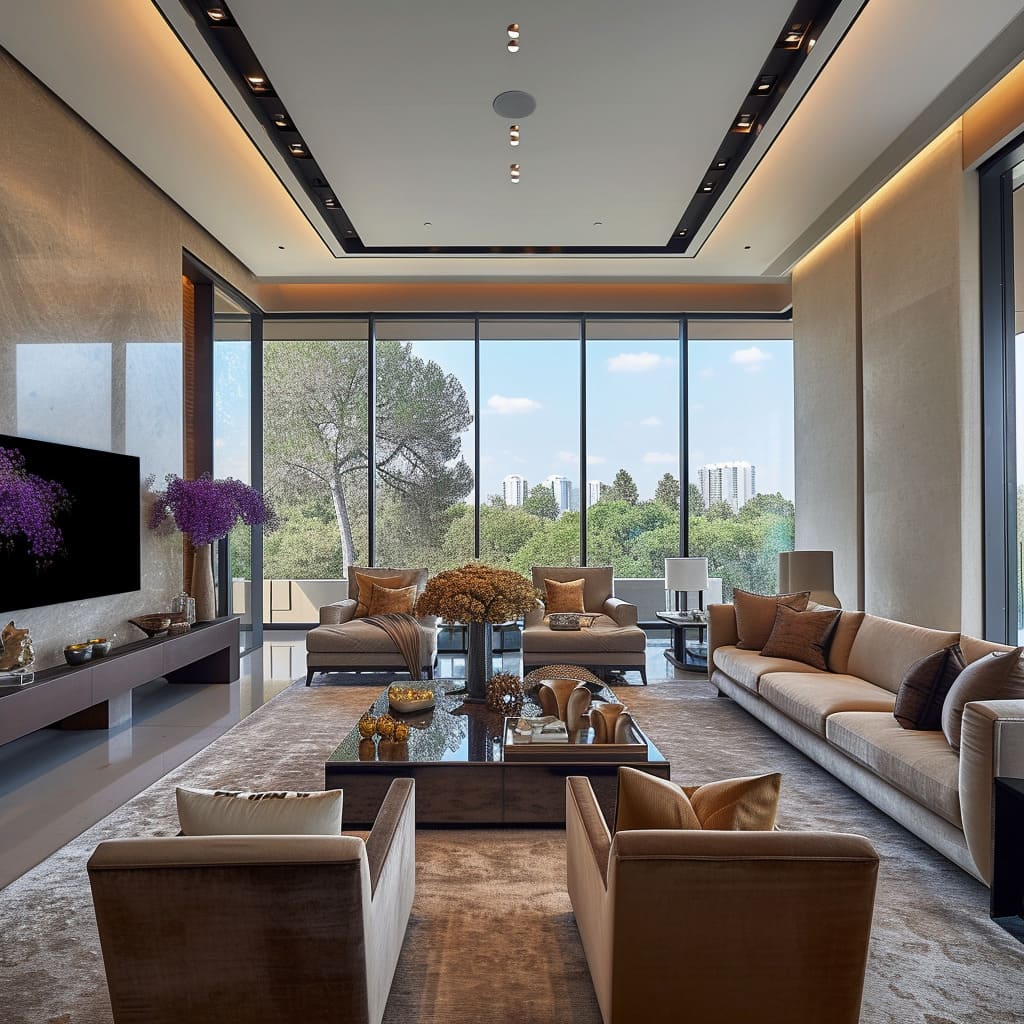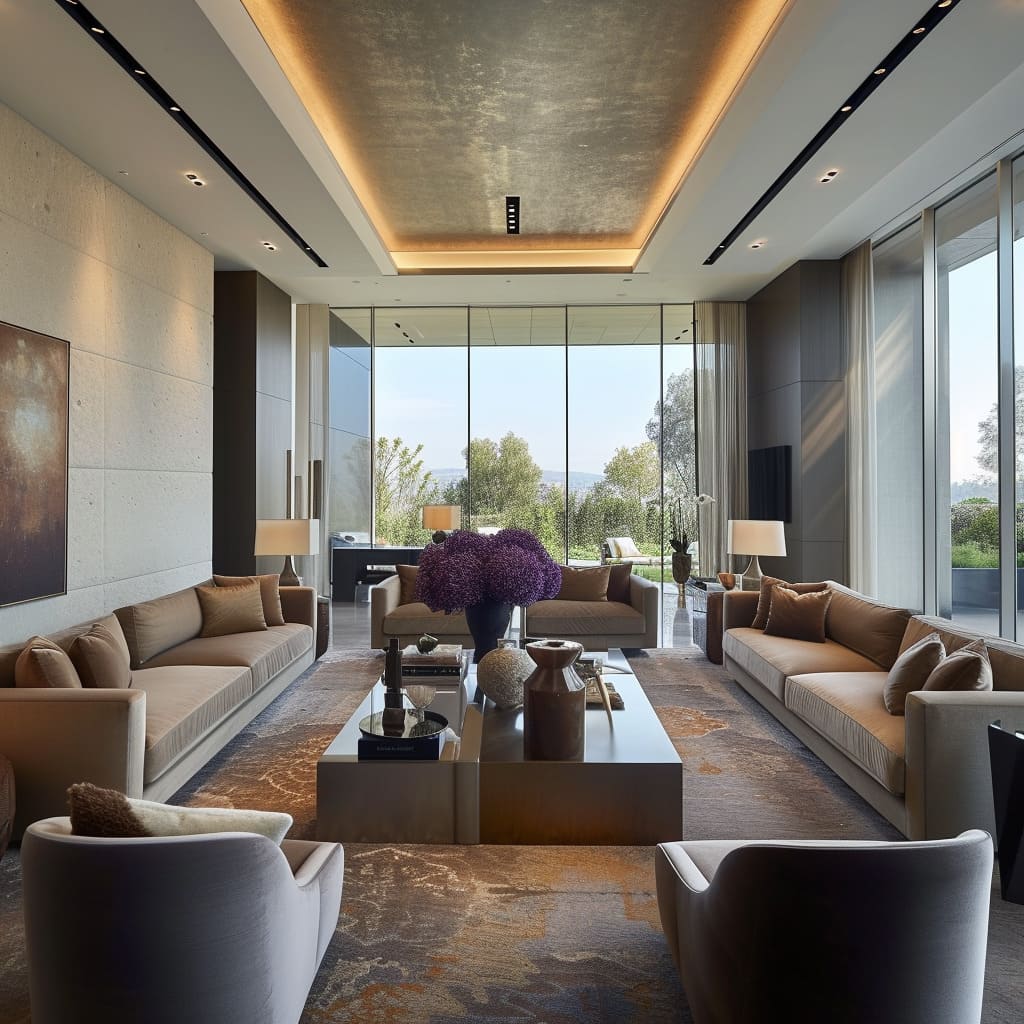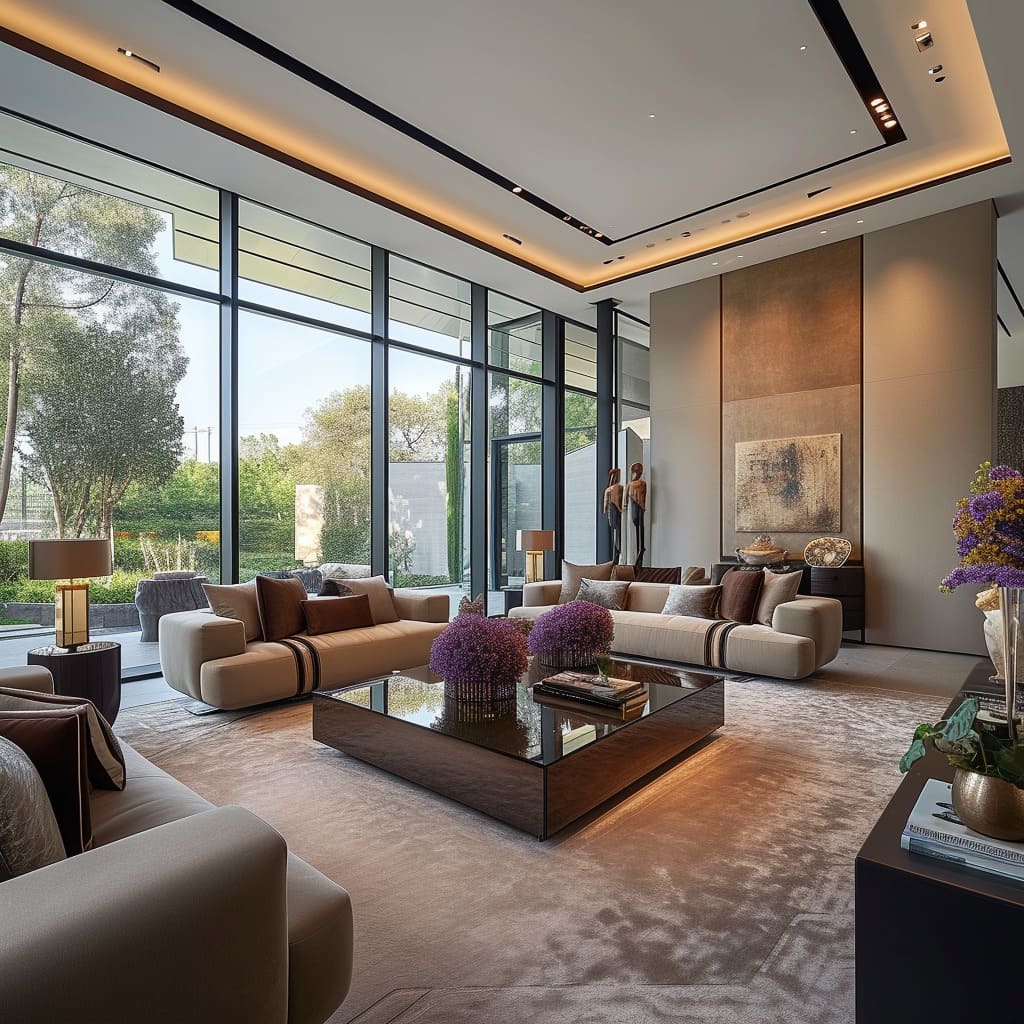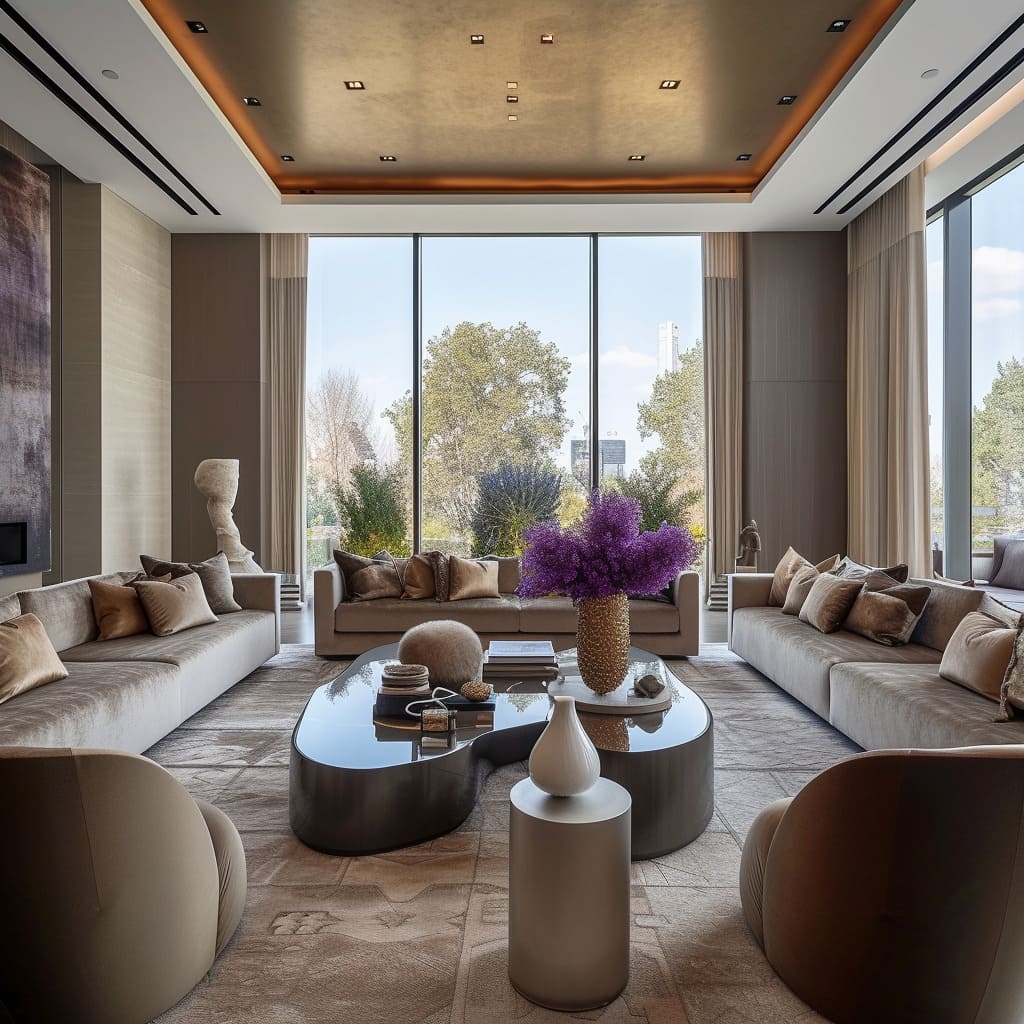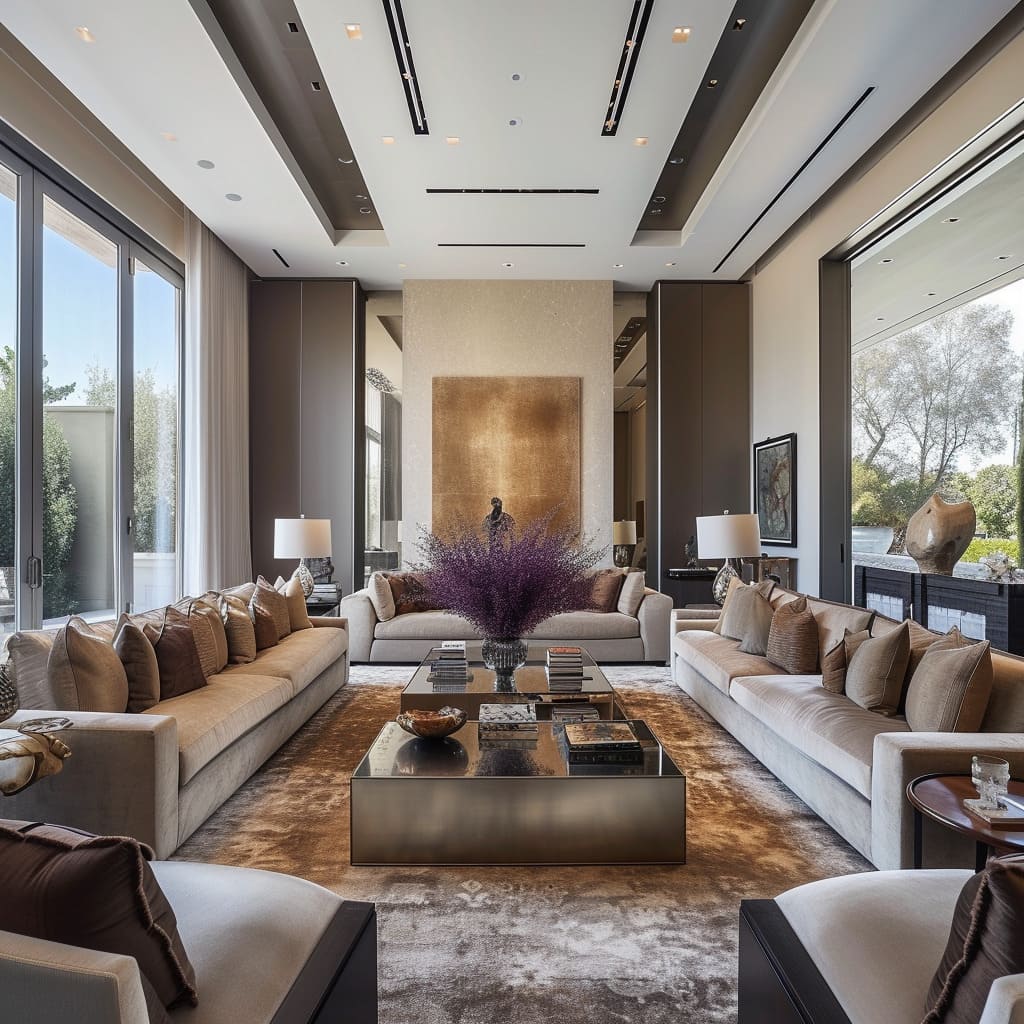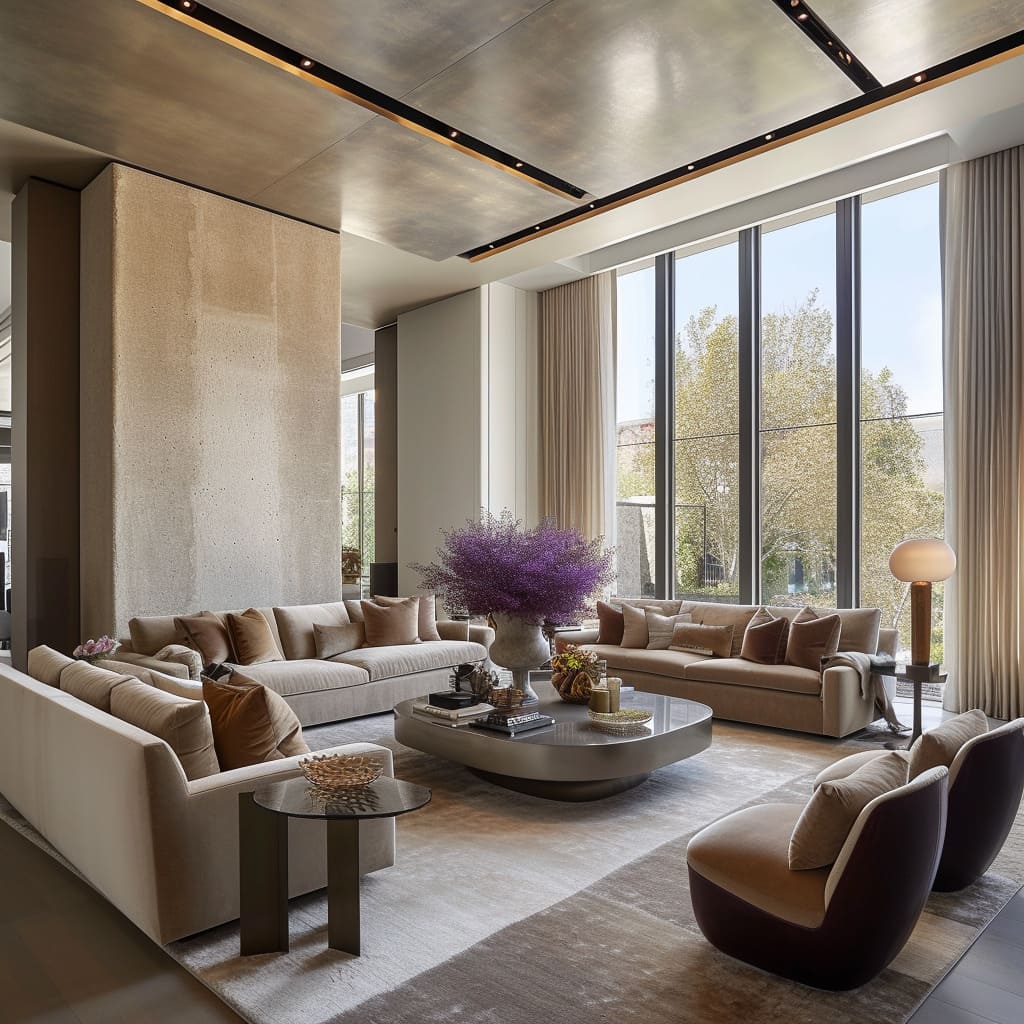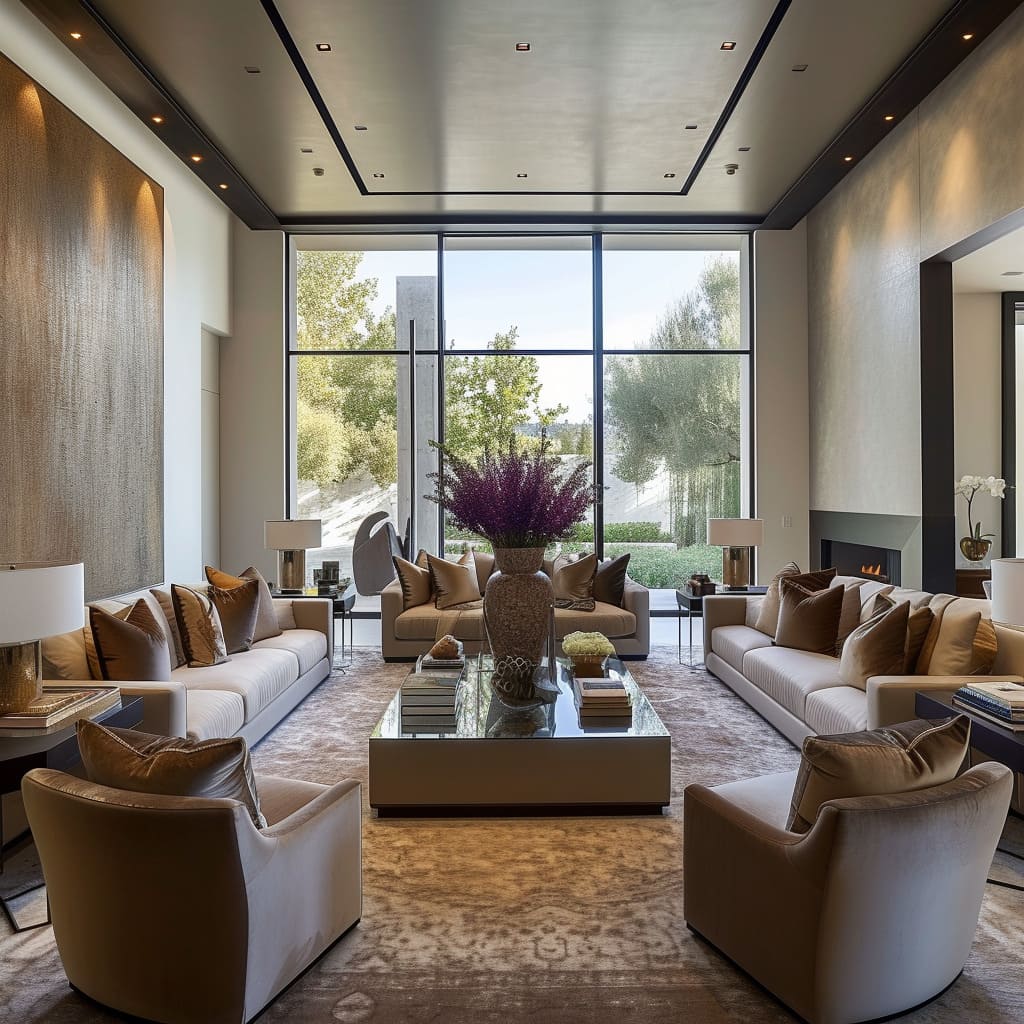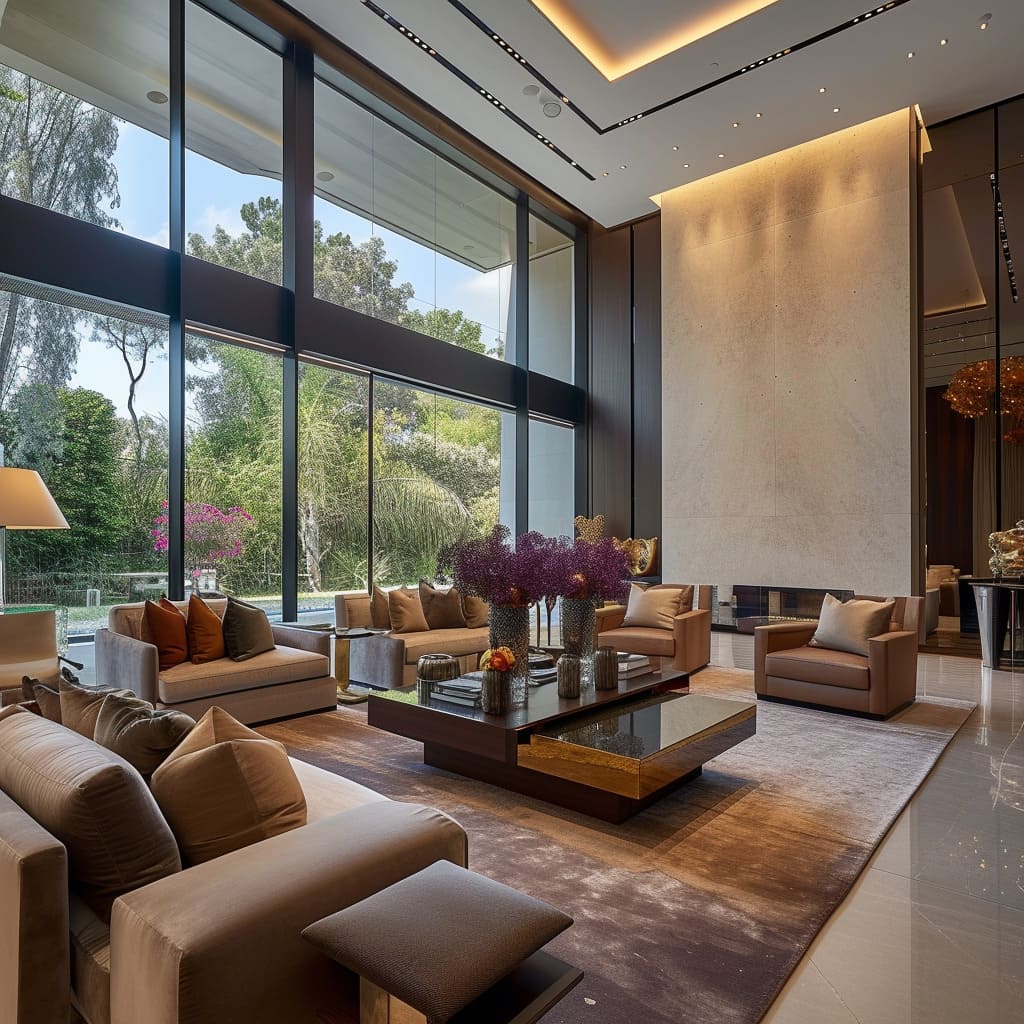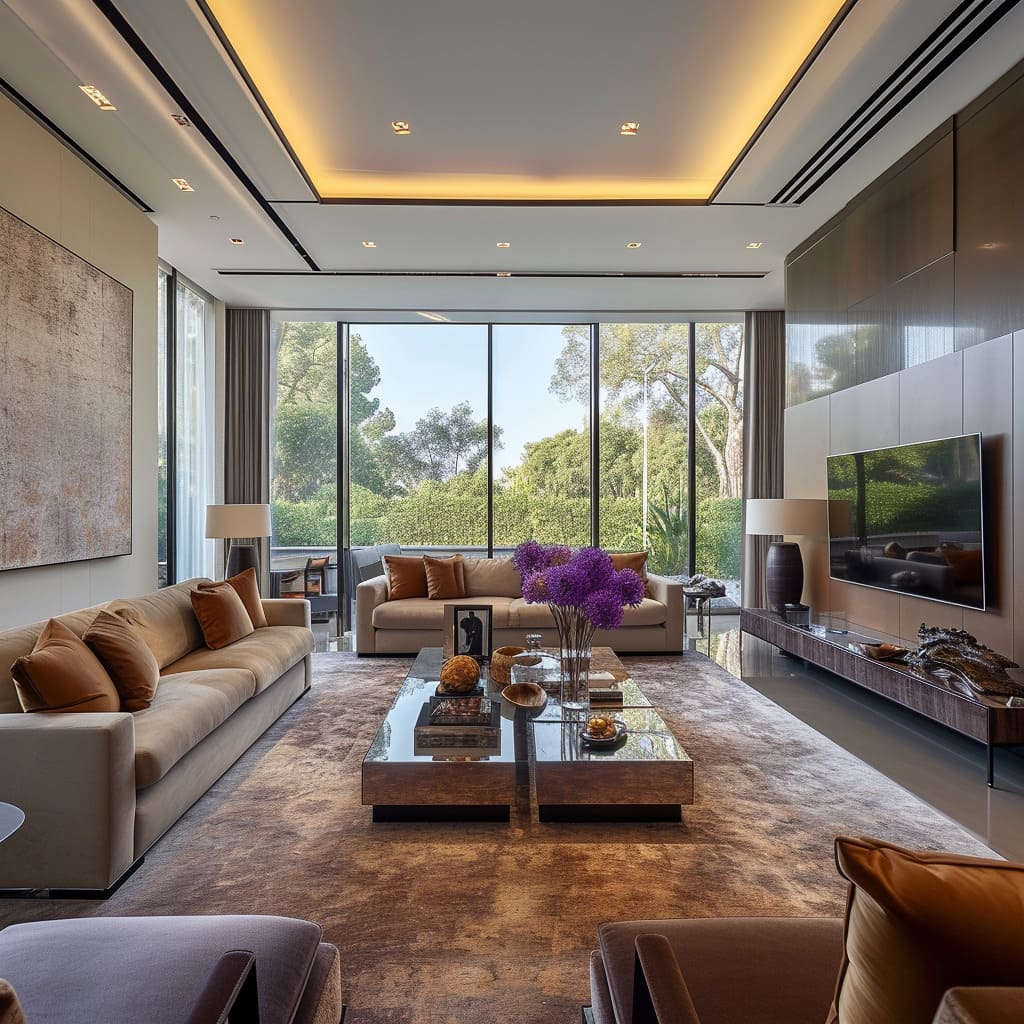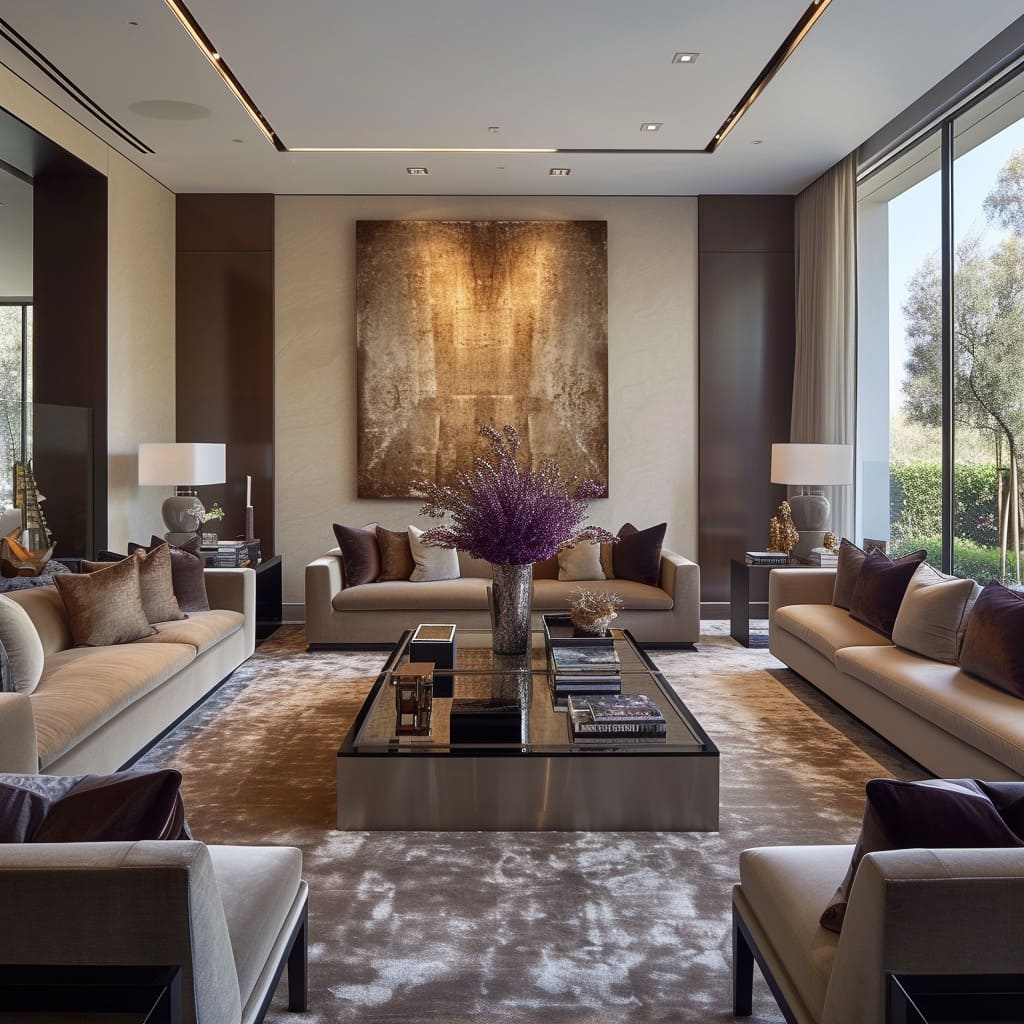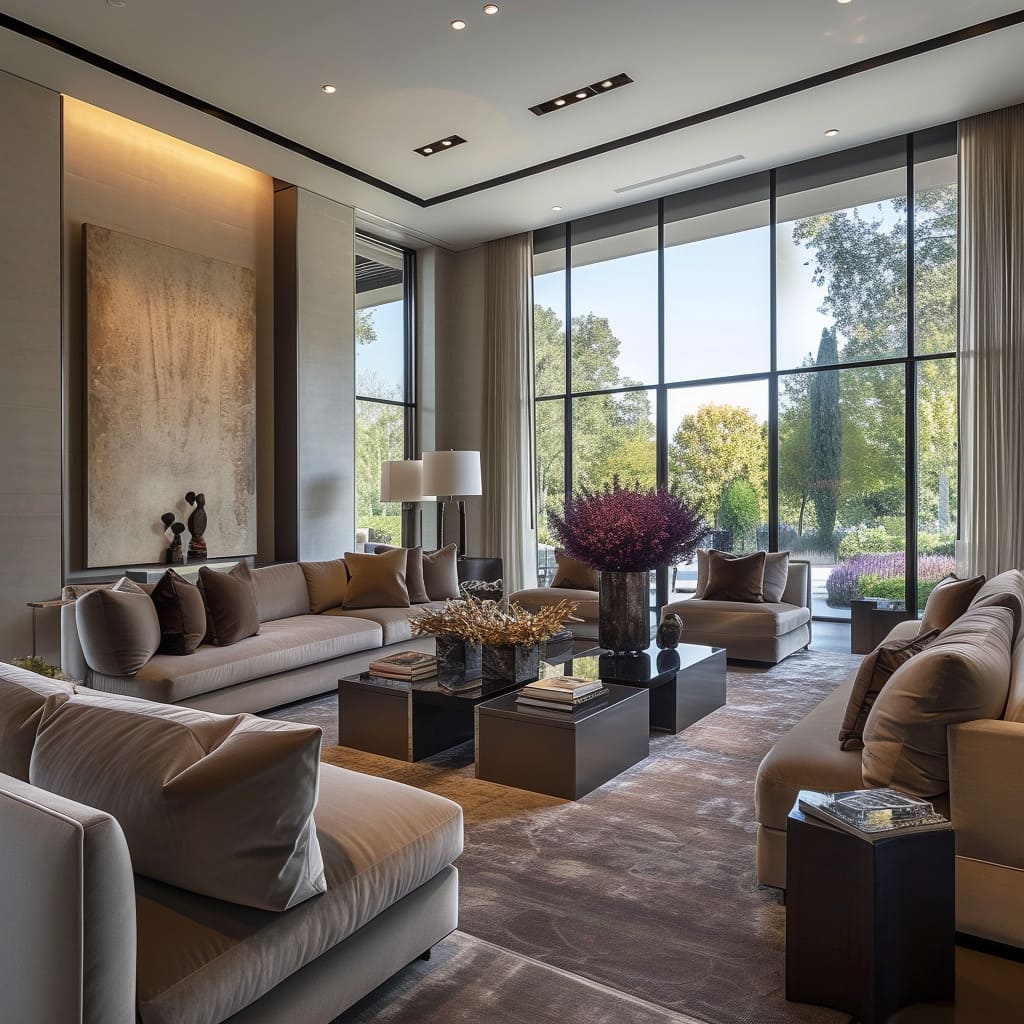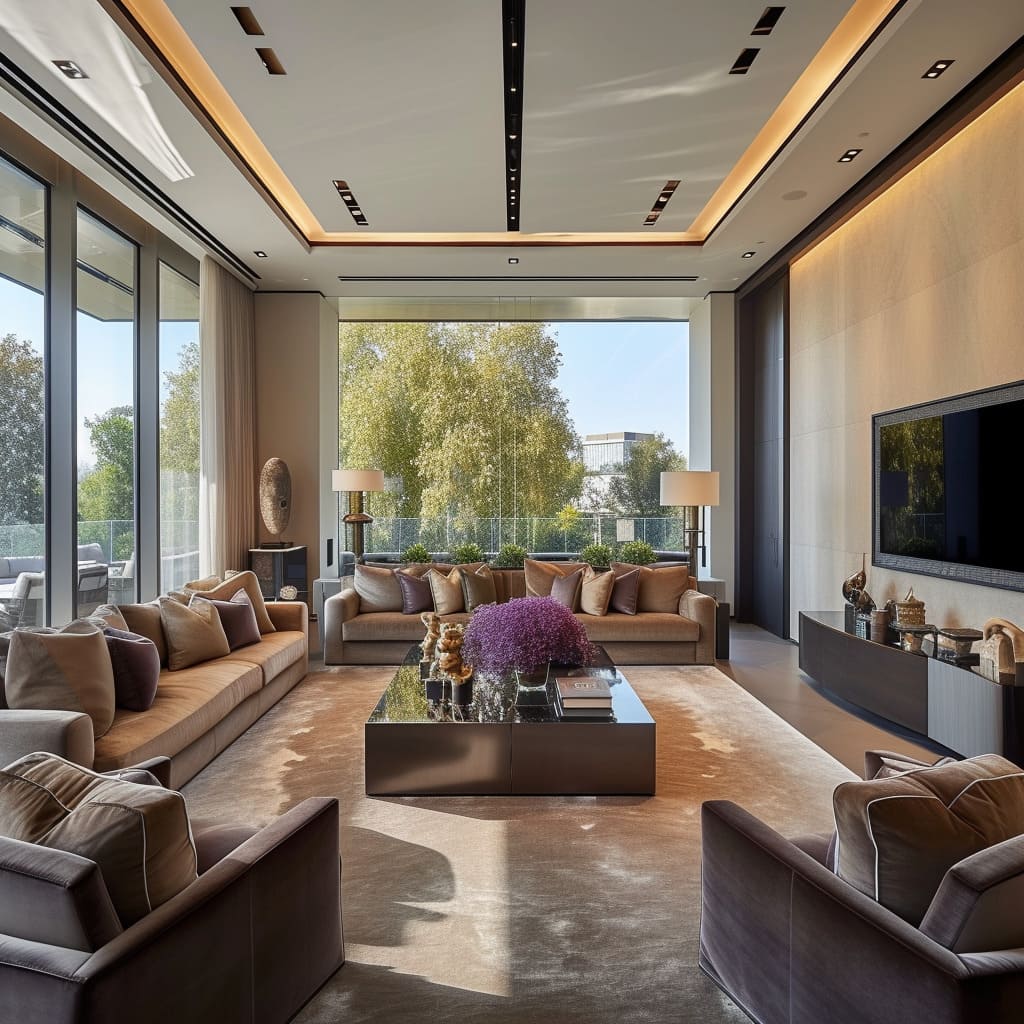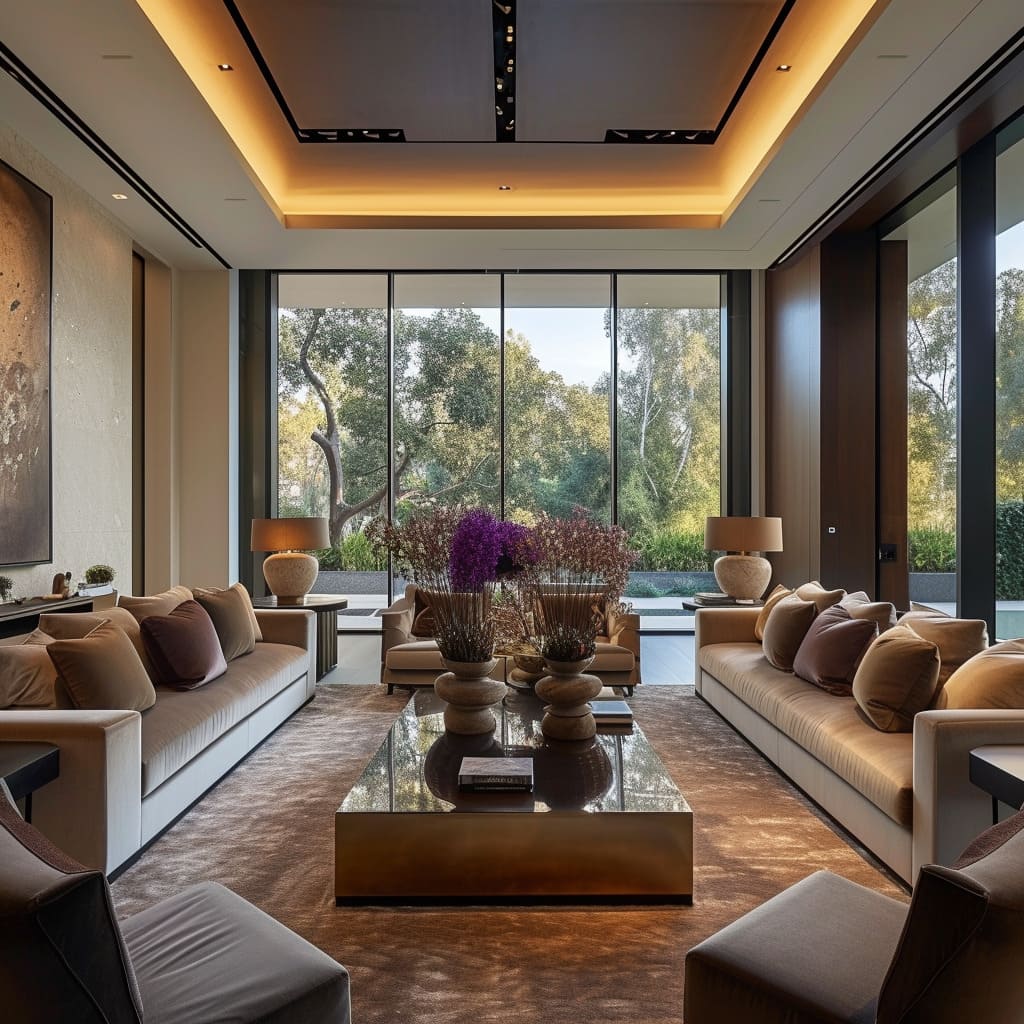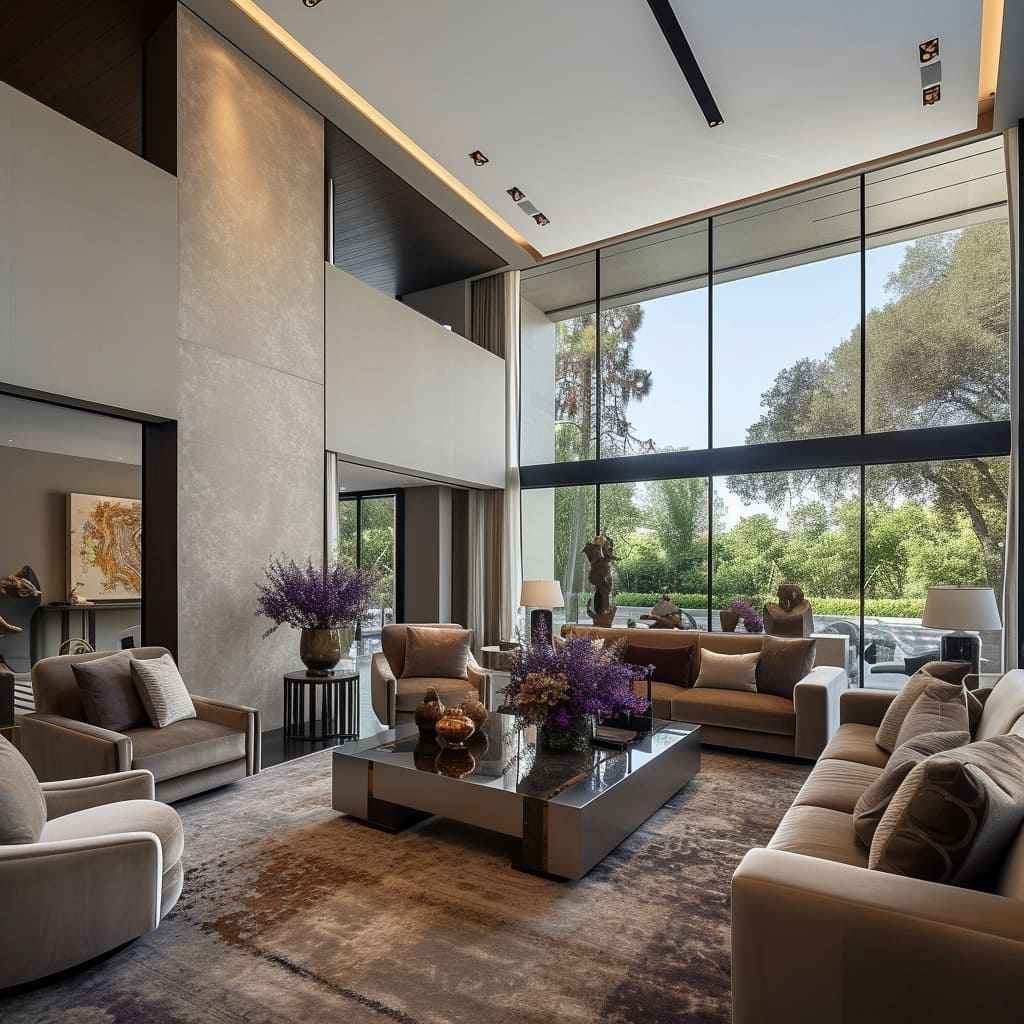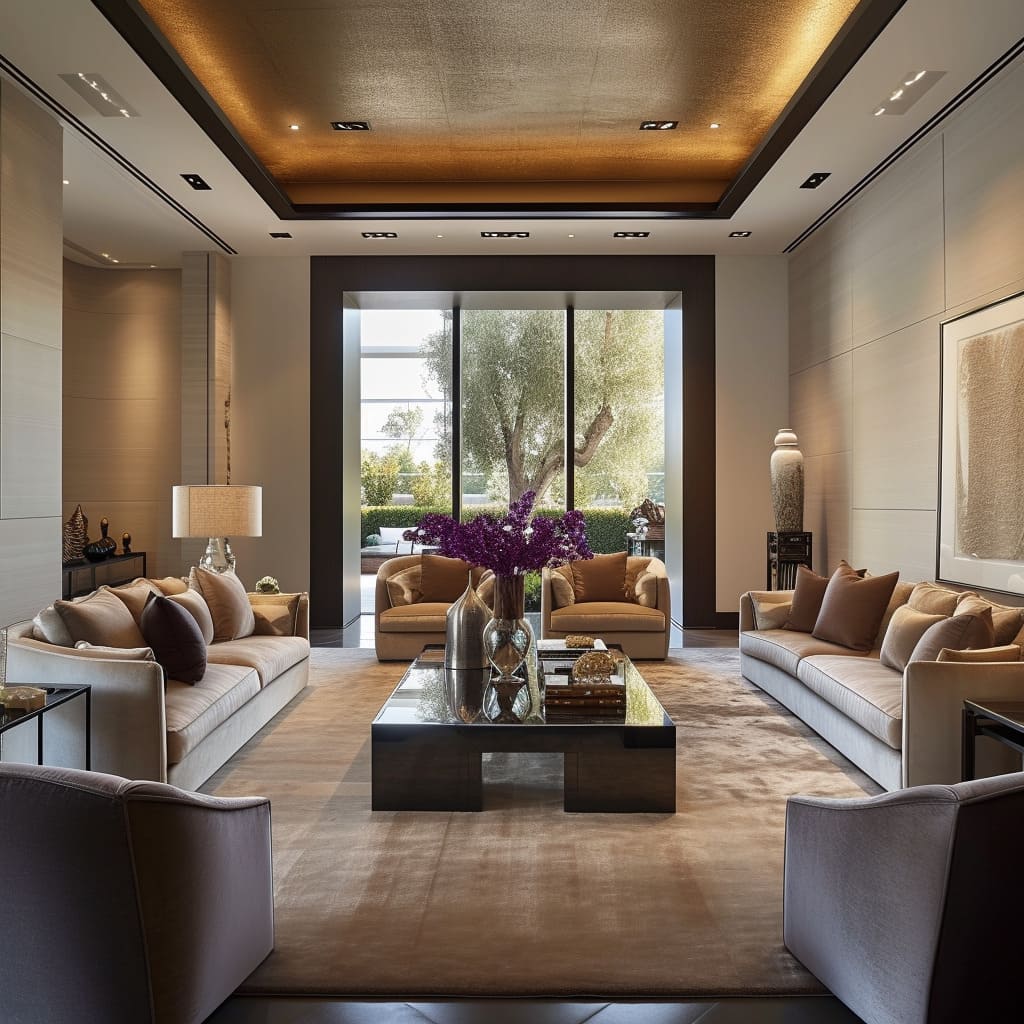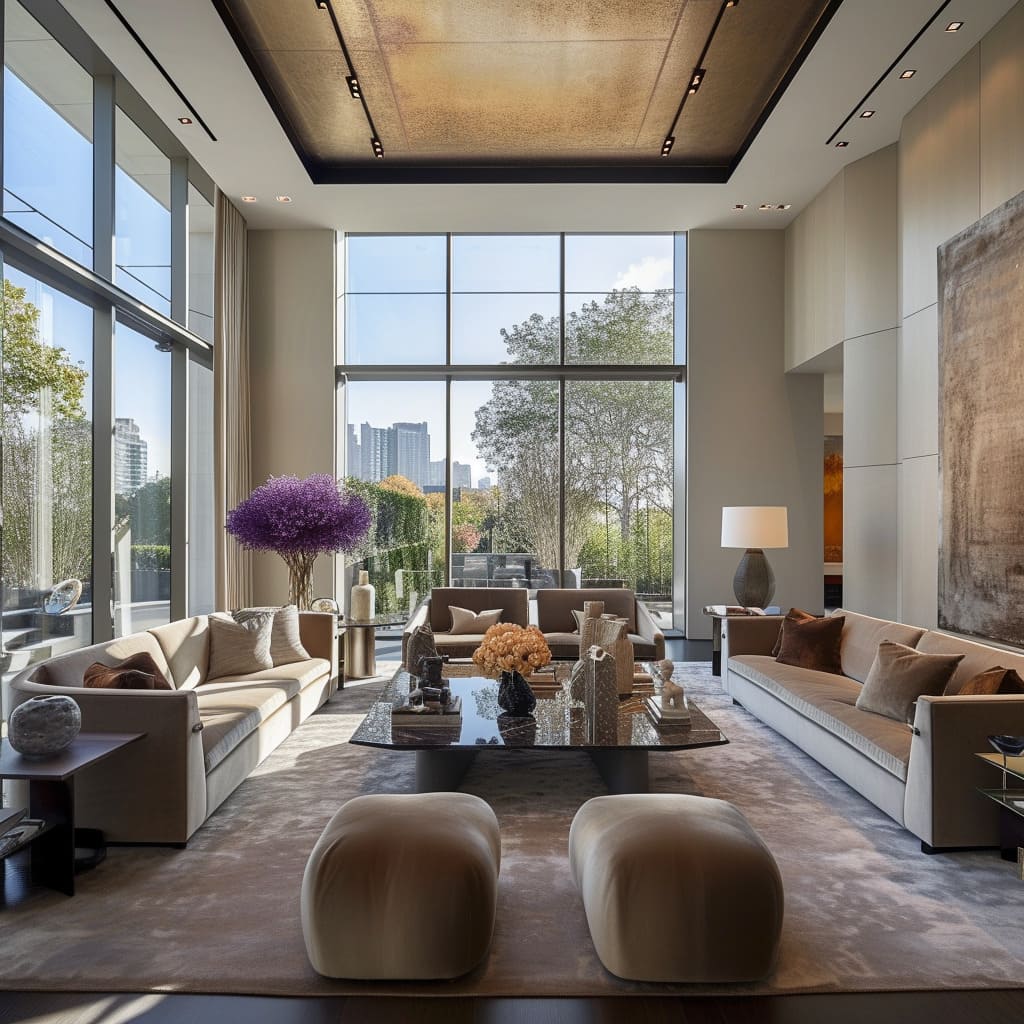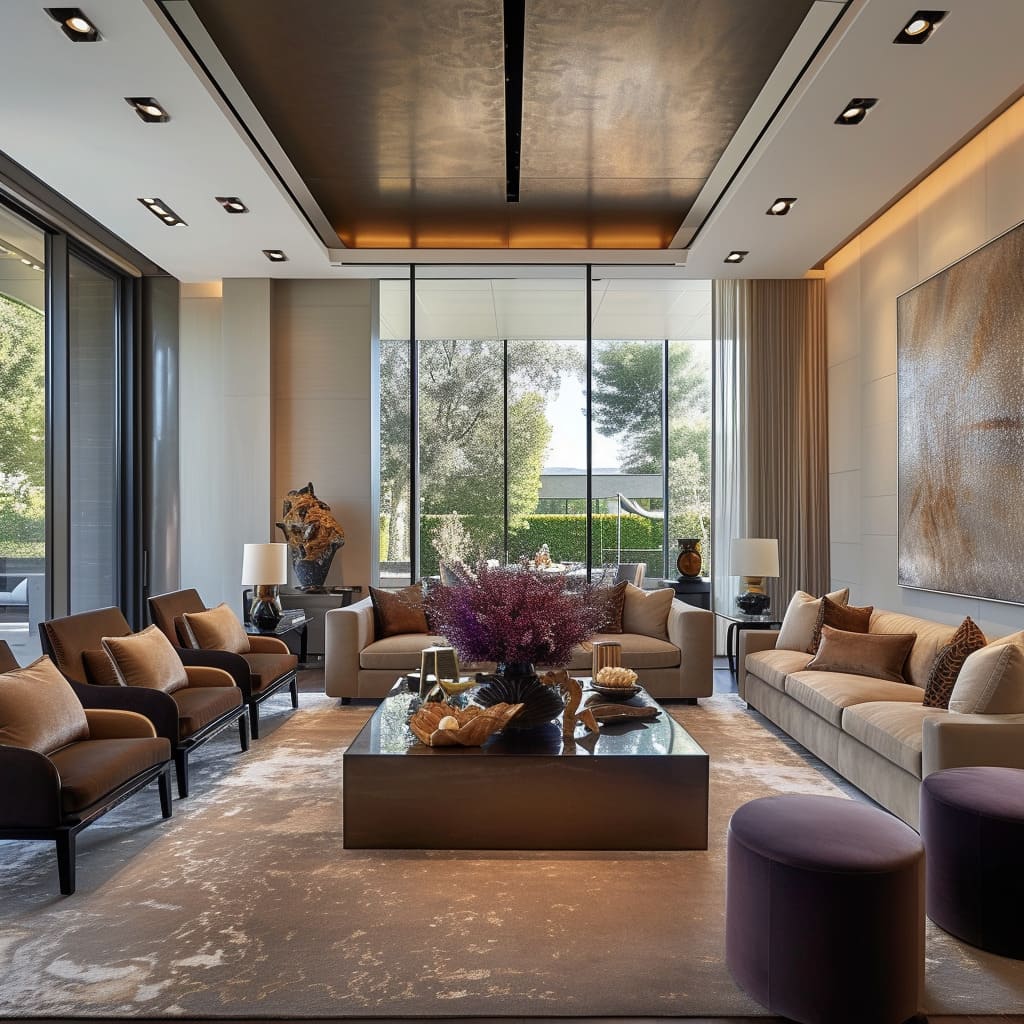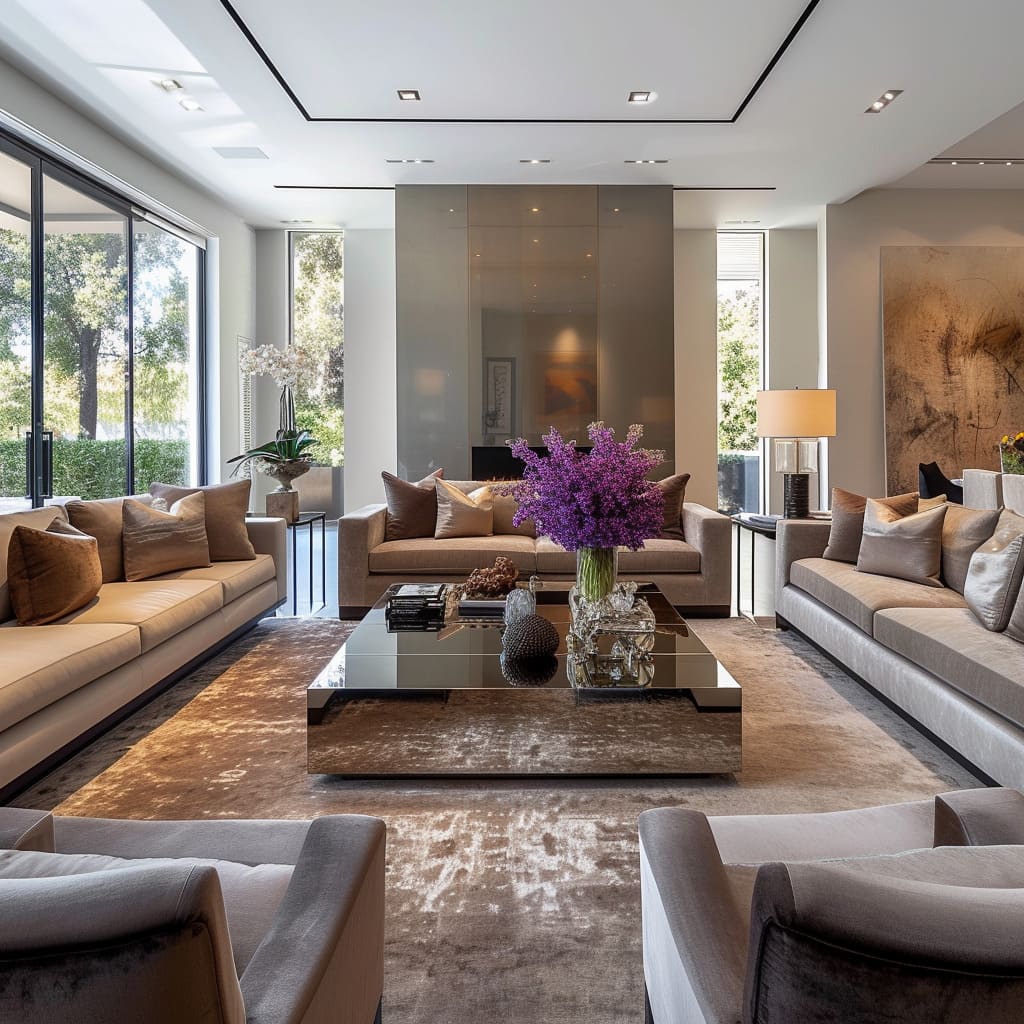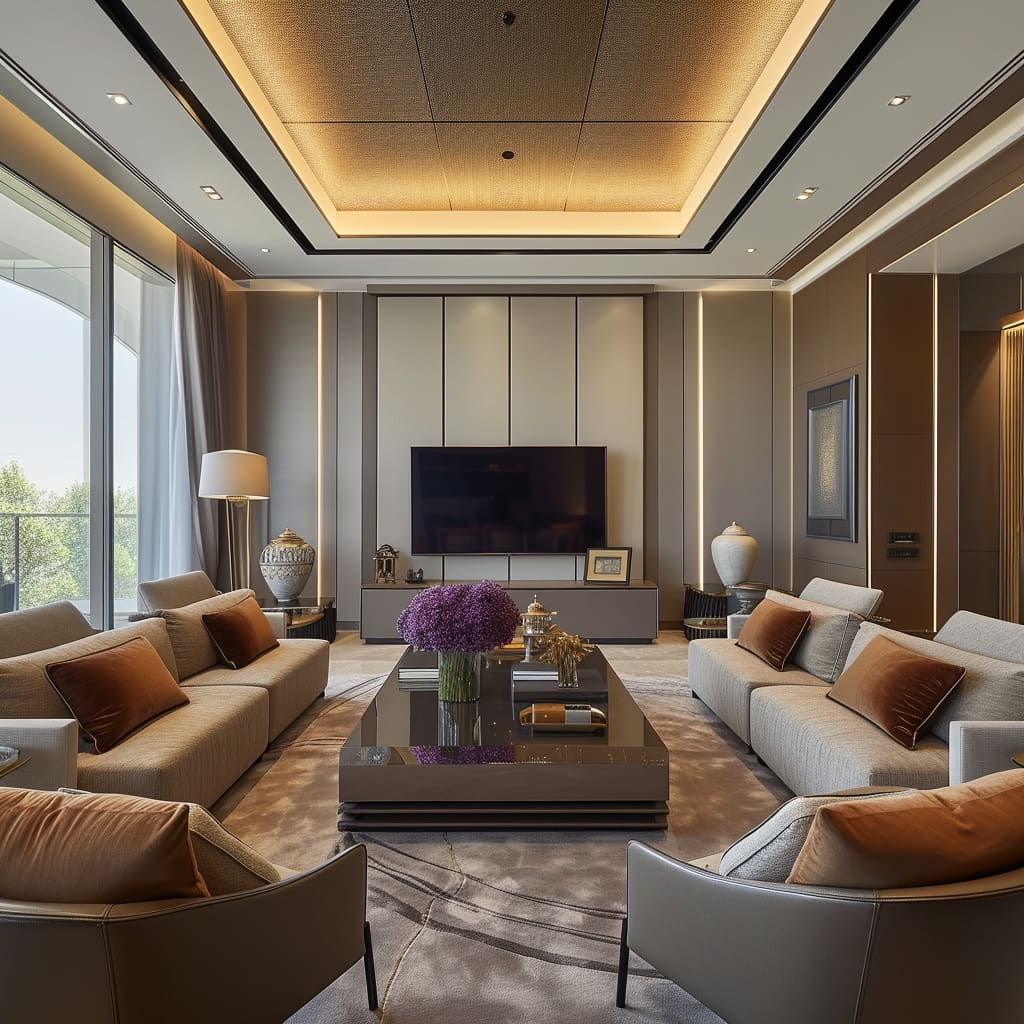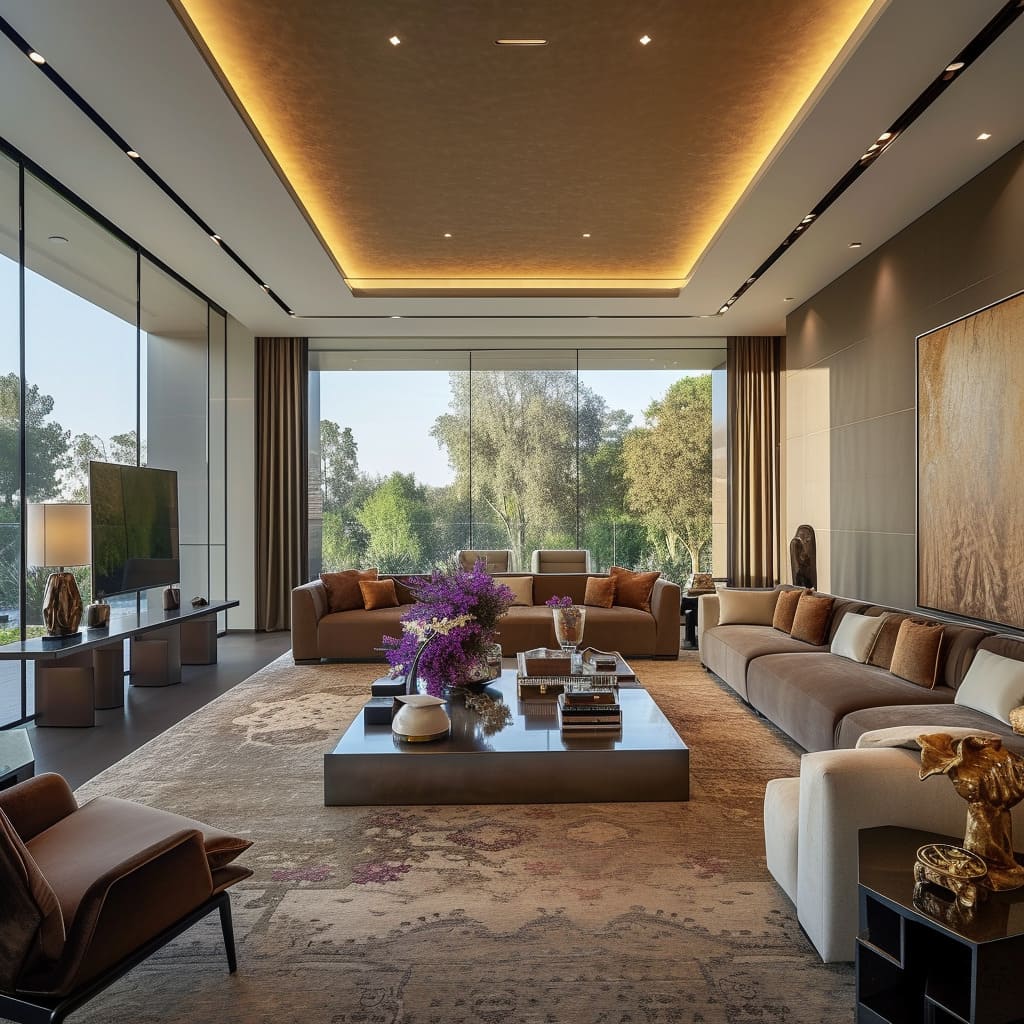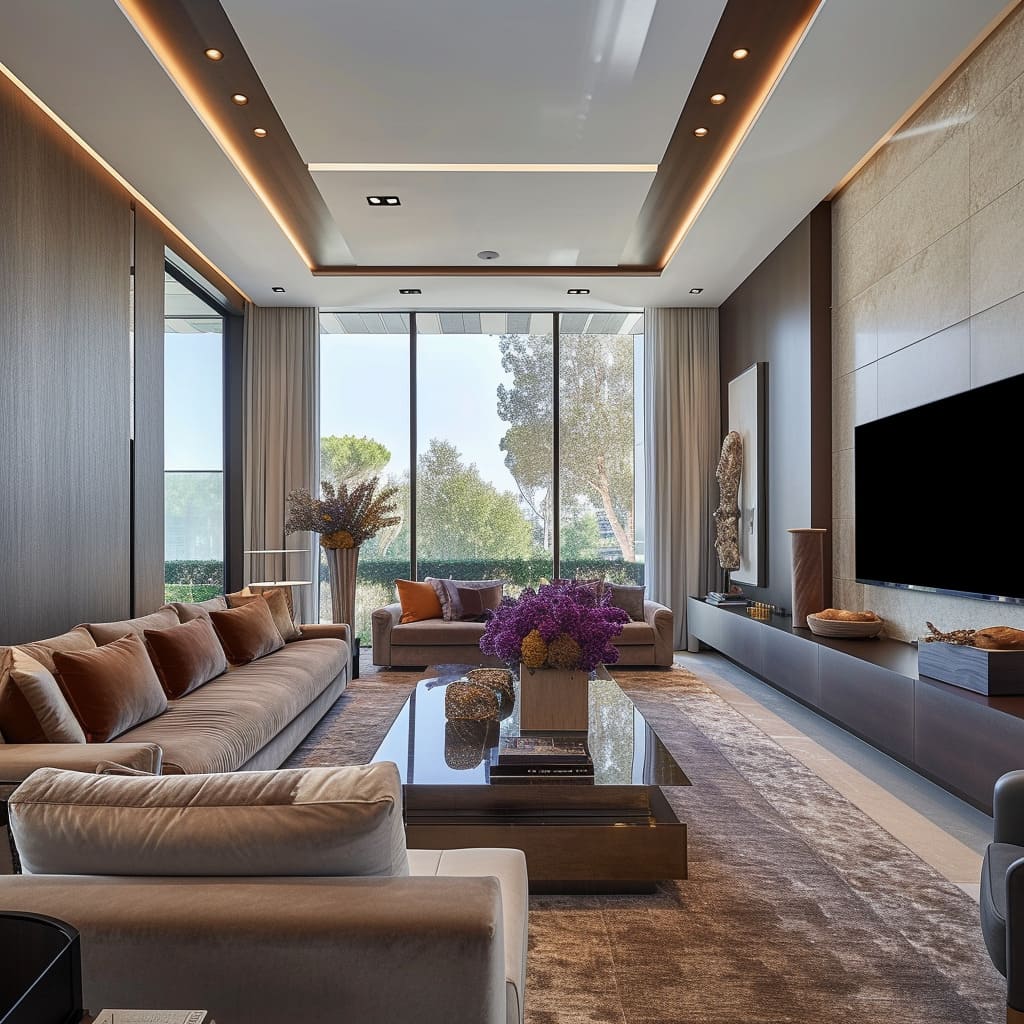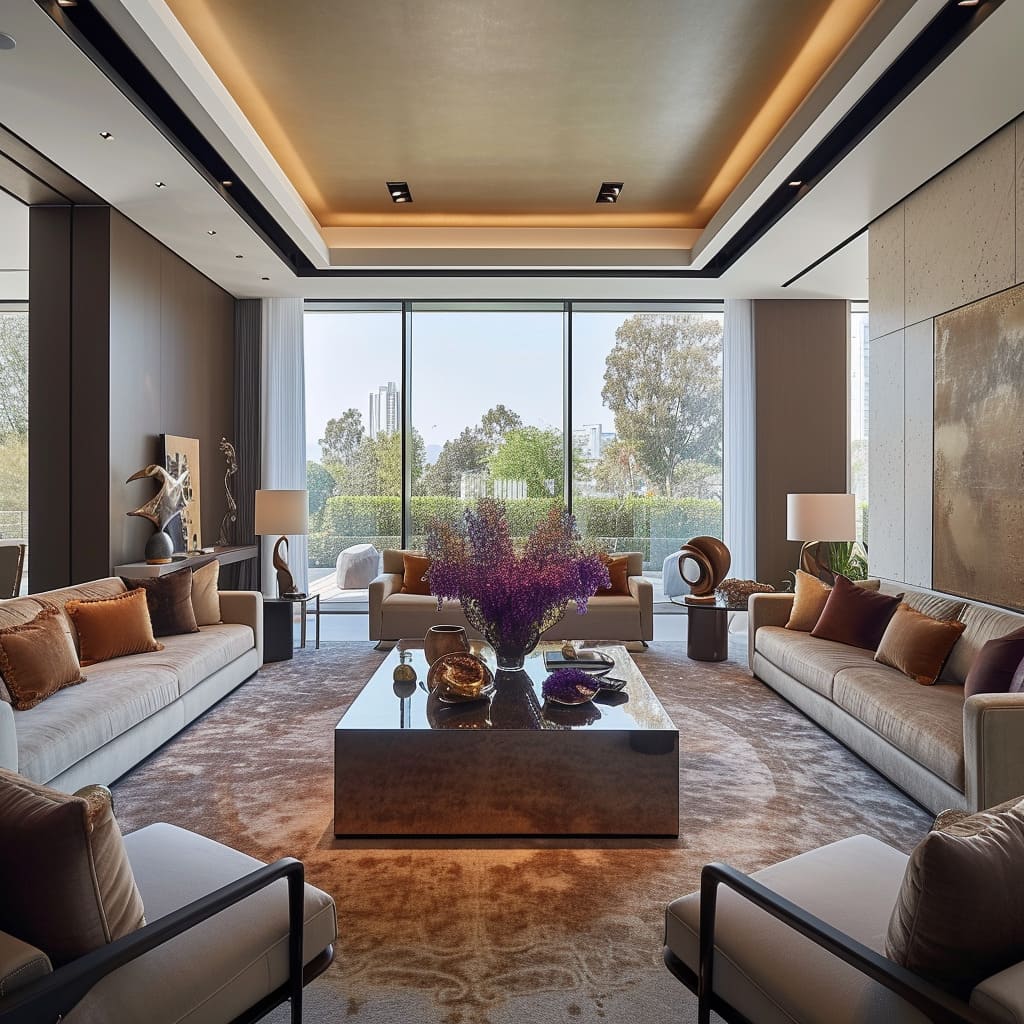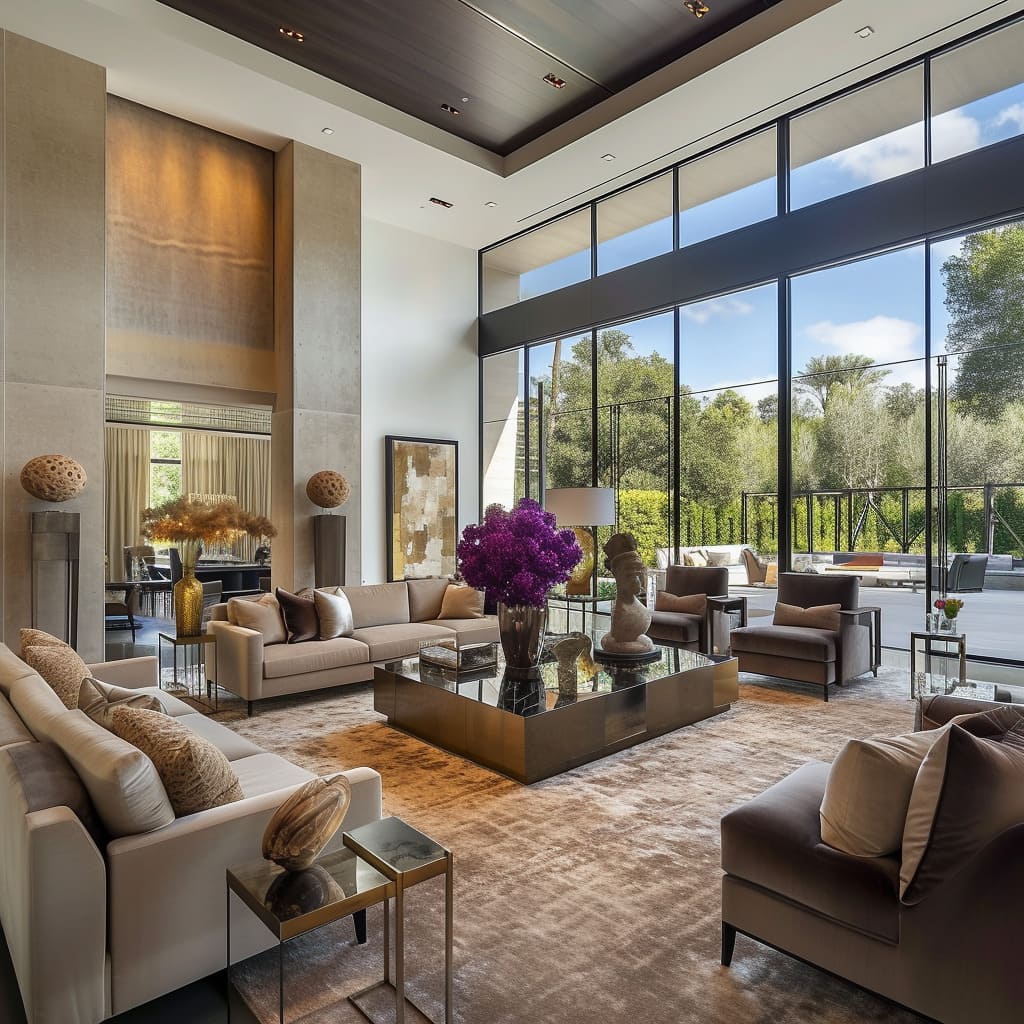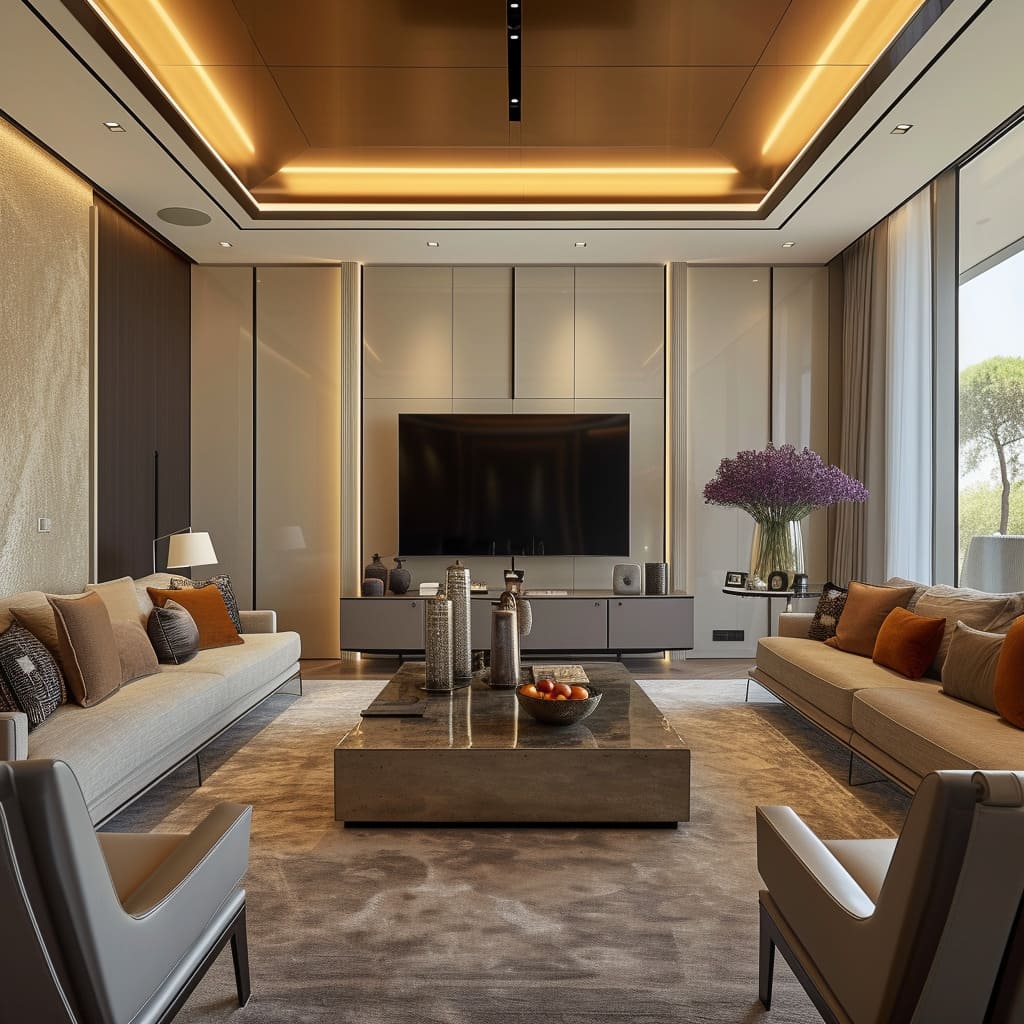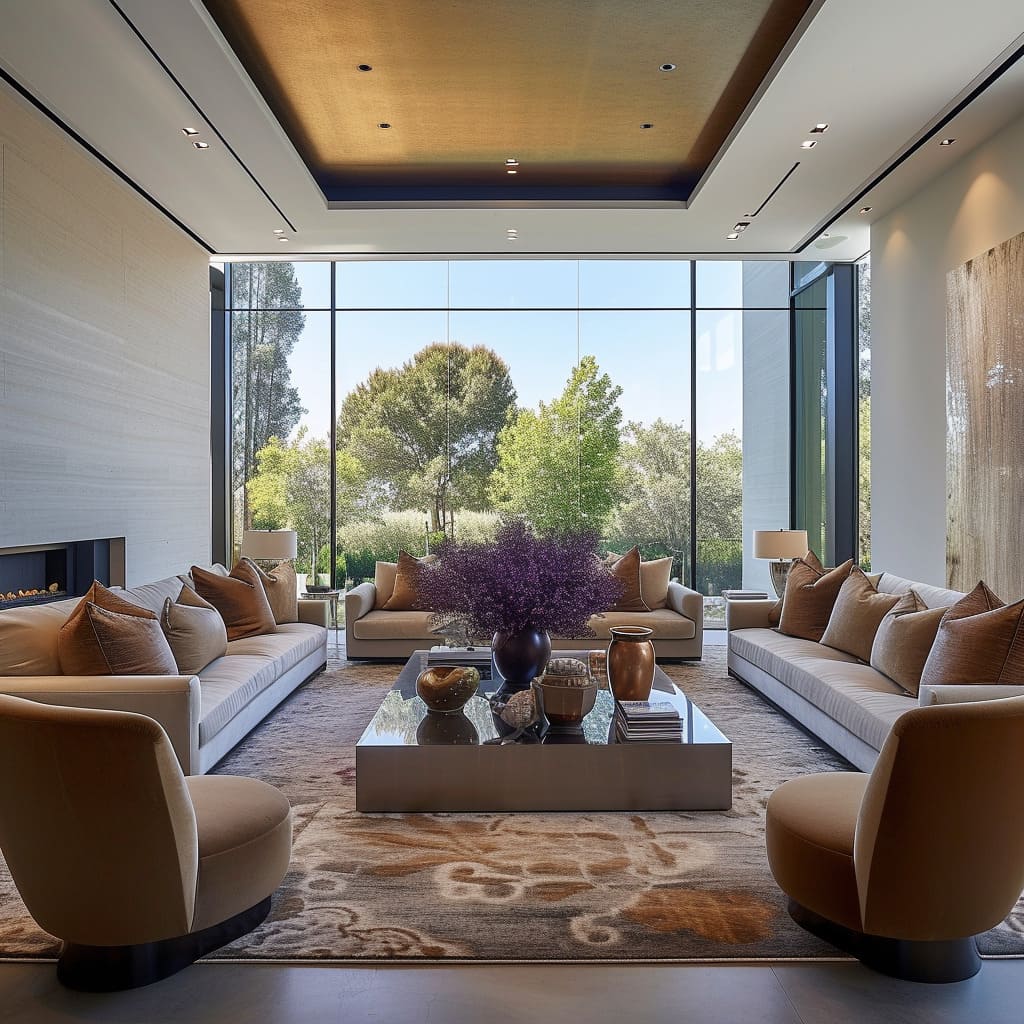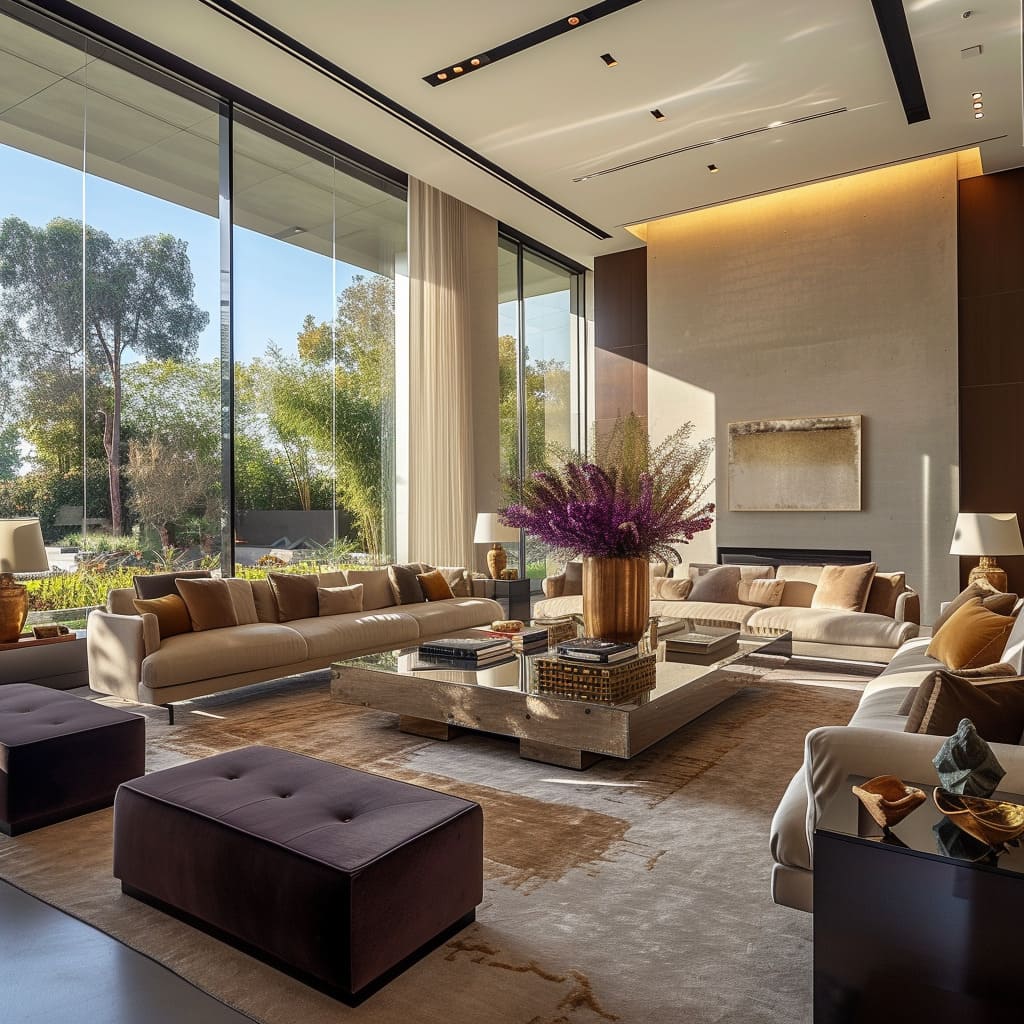The confluence of elements that shape a room’s character is an artful pursuit. Beyond mere functionality, the essence of a space is curated through an intimate dialogue between structure, palette, and adornment.This article peels back the layers of design to reveal the intricate dance of furnishings, color schemes, overhead artistry, and the boundless embrace of natural light. It is here, in the interplay of these components, that we discover the alchemy that transforms empty volumes into havens of comfort and elegance.Join us as we traverse the curated spaces that exemplify not only luxurious living but also a masterclass in design synergy.
Crafting Comfort and Elegance with The Furniture Selection
The furniture selection is a masterclass in balancing comfort with aesthetics. Each piece is chosen for its clean lines and plush upholstery, exuding a minimalist yet inviting allure.The sofas and chairs in neutral tones provide a versatile foundation for the living spaces, creating a seamless flow that encourages relaxation. The coffee tables are often substantial and serve as a focal point, often made of reflective materials like glass or polished stone, adding a touch of elegance.
Expanding on this, the furniture’s form factor is not only visually appealing but also ergonomically designed, ensuring that style is matched with comfort. Armchairs with generous padding invite the body to recline, while sectional sofas offer versatile seating configurations.The tactile experience is as essential as the visual one, with fabrics ranging from soft velvets to durable tweeds that invite touch and ensure longevity.
To further accentuate the sophisticated vibe, occasional chairs with unique silhouettes or accent details like tufting or nailhead trim are strategically placed. These serve both a functional and aesthetic purpose, breaking the uniformity with their distinctive designs.In the context of the living room, they can create intimate seating areas or add a pop of texture.
For those looking to recreate such a look, it is essential to start with a neutral base for large furniture pieces and layer with textures and shapes. Consider a statement coffee table that doubles as art or choose side tables in materials that reflect light and add brightness to the space.Investing in quality pieces that balance form and function can ensure your space is both beautiful and practical.
Palette of the Earth: The Alchemy of Natural Hues
The use of earthy colors is deliberate, aiming to evoke a sense of serenity and warmth. These hues are known for their timeless appeal, and their prevalence in these living rooms—from the taupe and beige upholstery to the deeper browns of the wood elements—creates a natural continuity.The colors reflect the outside environment, blurring the lines between indoors and outdoors, and contribute to the tranquil atmosphere.
These colors also offer a versatile canvas for incorporating seasonal decor or personal touches. Cushions, throws, and rugs in complementary earth tones can add depth and interest to the room.The subtlety of the color palette allows for a play of light and shadow, with the changing daylight dynamically altering the ambiance of the space.
In examining the details, one might notice the strategic use of gradients and tones. For instance, a lighter rug might anchor the room, while darker accents in the form of lamps or artwork provide visual anchors.This careful layering of shades creates a space that feels cohesive and thoughtfully curated.
To implement earthy colors in your own space, it’s advisable to use them in large areas like walls, floors, or main furniture pieces. Then, layer with various textures like wood, stone, or metal to bring depth and interest.Subtle variations in color can be achieved through textiles and decorative items, which can be changed out with the seasons or as your taste evolves.
Ceiling Design
Attention to ceiling design significantly enhances the overall ambience. The use of recessed lighting and warm LED strips outlines the room’s architecture, highlighting the high ceilings and creating a cozy glow that accentuates the room’s dimensions.In some instances, the ceiling features a central recess, which can make the space feel more intimate despite its grand size.
Beyond the functional lighting, the ceiling may feature architectural elements such as exposed beams or tray ceilings that add character and a sense of craftsmanship to the space. The interplay of shadow and light across these features can create a dynamic visual effect as the day progresses.In more modern designs, the ceiling may also incorporate abstract art or sculptural elements, turning it into a fifth wall of design potential.
The ceiling’s color and material choices are also paramount; a glossy finish can reflect light and add a sense of spaciousness, while matte textures can absorb light, contributing to a more subdued, cozy atmosphere. Some ceilings may even include skylights, which can bathe a room in natural light by day and provide a view of the stars by night, adding an element of natural spectacle to the living space.
To incorporate such ceiling designs into your interior, consider the room’s height and natural light availability. In lower-ceilinged rooms, choose lighter colors and flat, unobtrusive fixtures to give the illusion of height.For rooms with high ceilings, you can afford to add bolder elements like dark colors or wood panels to bring the ceiling down and create a more intimate feel.
The Grandeur of Expansive Fenestration
The incorporation of extra-large windows is perhaps the most impactful feature. They not only flood the room with natural light, accentuating the earthy tones and illuminating the furniture, but also provide expansive views of the outdoors.The connection to nature is grounding and reinforces the serene quality of the earthy color palette.
The design of the window frames themselves is also a key consideration; sleek, minimal frames or even frameless designs can enhance the feeling of openness and continuity with the outdoors. Windows are often designed to open completely or partially, allowing for natural ventilation and a sensory connection with the environment through the sounds and smells of nature.
In terms of functionality, these windows often feature high-performance glass, which can offer thermal insulation and UV protection while maintaining transparency. This is essential for comfort and the protection of interior furnishings from sun damage.The strategic placement of windows can also capitalize on the path of the sun, utilizing passive solar heating when desirable or providing shade and coolness during hotter months.
For those seeking to incorporate extra-large windows into their homes, working with an architect or designer is crucial to balance the aesthetic desires with the structural and environmental considerations of your specific location. The integration of indoor and outdoor spaces through the use of large windows can transform the living experience, making the choice of window design and placement a critical aspect of the overall architectural plan.
Cohesion of Features
Together, these elements work in concert to create an environment that is both luxurious and livable. The furniture is positioned to invite conversation while allowing unobstructed views through the windows.The earthy colors connect the space to the natural world outside, and the subtle ceiling design adds depth and warmth. Each feature complements the others, resulting in a holistic design that feels both planned and effortless.The use of reflective surfaces and strategic lighting further unifies the space, making it dynamic yet harmonious.
The deliberate positioning of furniture, not just for aesthetic appeal but for the flow of movement, creates an intuitive navigation through the space. This is achieved by establishing clear pathways between furniture arrangements while ensuring that each seating area remains cozy and conducive to engagement.The placements are such that they harness the strengths of natural light during the day, transitioning smoothly into the warmth of ambient lighting at night.
Artwork and decorative elements are chosen not only for their stand-alone beauty but for their ability to bridge different aspects of the room, whether it’s a sculpture that echoes the form of the furniture or a painting that draws out the underlying hues of the room’s color scheme. Accessories are used sparingly, ensuring that each piece has room to breathe and be appreciated, contributing to the room’s overall narrative rather than overwhelming it.
Incorporating such a cohesive design in your own home requires a thoughtful approach to each selection and placement. Begin by considering the room’s purpose and how you want to feel in the space.Use a consistent color palette to unify the room, and select furniture that balances scale, material, and color. Ensure lighting is layered to provide ambiance and functionality, and choose art and accessories that complement rather than compete with the room’s design.Remember that in a well-designed space, less is often more, and quality should always precede quantity.
Creating a cohesive interior design is akin to composing a symphony where each element has its part to play. Furniture should not only converse with the other pieces in the room but also with the architectural elements such as the windows and ceilings.When all parts harmonize, the result is a space that resonates with beauty, balance, and a sense of peace. This is achieved not by chance but through deliberate design decisions that consider every angle, from the way the morning light dances across the room to the evening shadows that bring a sense of calm.Each piece in these rooms has been selected for both its individual beauty and its contribution to the room’s collective aesthetics.
To attain such design cohesion in your own space, it’s vital to start with a clear vision and a consistent theme. Choose a color palette that resonates with the mood you wish to create, and select pieces that fit within this scheme while offering their unique charm.Consider the scale of your furniture in relation to the room and ensure that it complements the available space without overwhelming it. When choosing decorative items, look for pieces that not only speak to you personally but also work together to enhance the room’s overall feel.Finally, let the architecture of your home guide you. Work with the existing elements, such as windows and ceilings, and allow them to inform your choices, ensuring that your interior design feels like an organic extension of the structure itself.
As our journey through the tapestry of interior design concludes, we are left with a profound appreciation for the silent poetry that resonates within well-composed spaces. The care with which each element is selected and woven into the fabric of the room’s identity is a testament to the power of thoughtful design.Artisanal furnishings, the richness of earth-inspired colors, the deliberate sculpting of ceilings, and the grandeur of windows that frame nature’s masterpieces—all contribute to the symphony of spatial harmony. This exploration has not just been an exercise in aesthetics; it is an invitation to reconceive our own living spaces as canvases for personal expression and sanctuaries for life’s cherished moments.Let the insights gleaned here inspire a new chapter in your home’s story, one that celebrates the beauty of cohesion and the quiet luxury of a space that truly feels like your own.


